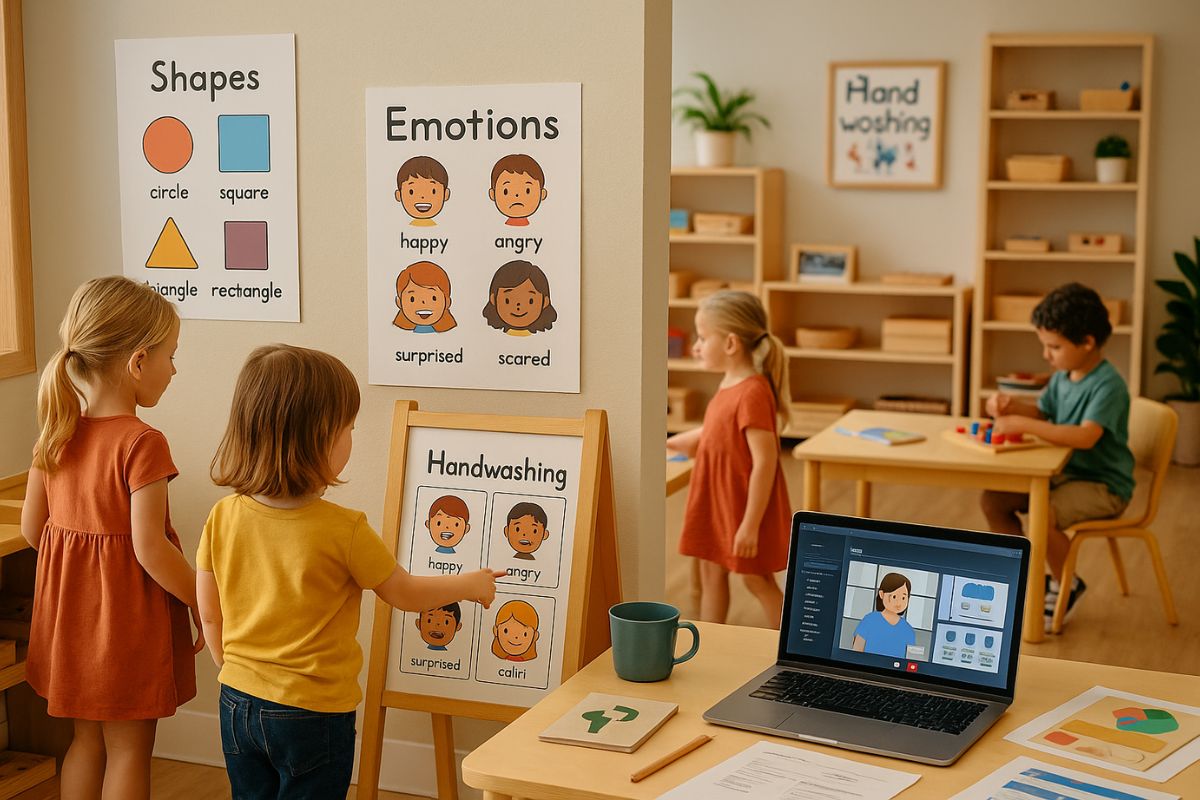In a classroom full of movement and questions, not every child will respond best to verbal instructions. For many young learners, especially those still developing language or navigating new routines, visual symbols offer clarity, comfort, and independence. These simple tools—icons like smiley, images, or color cues—can make a big difference in how children understand their space and interact with the world around them.
Visual symbols are more than decoration. When used thoughtfully, they become part of the language of the environment. They support children in making choices, following steps, and feeling a sense of order. For educators, they provide a silent yet powerful way to communicate expectations without interrupting the child’s focus.
Why Visual Cues Matter in Early Learning
This article explores how visual symbols serve as valuable tools in early learning environments. It highlights their impact on routine-building, self-regulation, and autonomy—especially within frameworks like Montessori that respect each child’s developmental pace.
Supporting Independence Without Words
Young children may not always have the vocabulary or listening stamina to follow spoken instructions, especially in busy group settings. Visual symbols offer a bridge. When a child sees a shoe icon on a basket, they know where to find what they need. When a sequence of images shows handwashing steps, they can follow through without an adult’s reminder.
This autonomy builds confidence. It also reduces stress—for both the child and the adult. Instead of constantly correcting or repeating, teachers can point gently to a visual reminder, keeping the tone respectful and the atmosphere calm.
Montessori environments often rely on minimal adult direction. Visual cues align perfectly with this philosophy, allowing the environment itself to teach.
Creating Order Through Consistency
Children thrive on routine. But remembering every part of a classroom schedule or task sequence can be overwhelming, especially for children with developing executive function skills.
Visual schedules—using pictures, symbols, or icons—help make time more predictable. A child who sees a simple timeline showing circle time, snack, work period, and outdoor play knows what’s coming next. This kind of structure doesn’t limit spontaneity—it makes space for it by reducing anxiety about the unknown.
Consistency is key. When the same symbols are used day after day, children begin to internalize them. Over time, those external signs become part of the child’s internal framework for understanding and organizing their day.
Encouraging Focus and Flow
A child deeply focused on a task may not notice verbal cues around them. But a quiet symbol, placed at eye level, can offer direction without interrupting concentration. For example, a stop sign on a shelf indicates a material is being used. A color-coded mat signals a space for specific work.
These nonverbal signals help keep the learning space organized while respecting the child’s ability to stay immersed in their work. Visual symbols support what Montessori called “normalization”—the child’s natural state of focused engagement—by offering subtle structure without disruption.
Bridging Communication Gaps
Not all children in early learning environments are fluent in the classroom’s dominant language. Some may be learning English, while others may speak multiple languages at home. Some children may have speech delays or other communication differences.
Visual symbols are inclusive. They provide a shared language that doesn’t rely on spoken words. This opens up participation for every child, regardless of background or developmental stage. It also teaches empathy—when children see that everyone has tools to support their learning, they begin to value difference rather than fear it.
Supporting Emotional Regulation
Symbols can also help children name and manage emotions. Feelings charts, with expressive faces or body cues, help children recognize how they feel. A quiet corner with a symbol indicating “peace place” or “take a breath” offers a nonjudgmental space for calming down.
Rather than being sent away or told what to do, children learn to check in with themselves. Visual cues guide them through the steps of self-regulation, gently reinforcing that emotions are normal and manageable.
In this way, symbols support not only practical learning, but emotional growth as well.
Designing with Purpose
For visual cues to be effective, they must be accessible and developmentally appropriate. Symbols should be placed at the child’s eye level. They should be simple, consistent, and meaningful. Colors can help distinguish areas or activities, but too much clutter can overwhelm.
Educators often create their own visual tools tailored to the needs of their class. In some Montessori settings, photos of actual children or materials are used instead of generic clipart, making the symbols more personal and concrete.
Thoughtful design isn’t just about aesthetics. It’s about honoring the child’s ability to navigate their environment independently and with confidence.
A Quiet Partner in the Classroom
In many ways, visual symbols act as silent assistants. They provide support without needing attention. They whisper instructions instead of shouting. And they empower children to do more on their own.
This is one of the key values in Montessori: trust the child. Trust them to move through their day, handle responsibility, and make thoughtful choices. Visual symbols don’t make the child dependent on the environment—they help the child master it.
They become part of the child’s inner toolkit, shaping how they approach learning and life.
Growing Beyond the Classroom
The benefits of visual symbols don’t stay within classroom walls. Children who’ve learned to follow visual cues often carry that skill into other settings—home routines, public spaces, or group activities. They learn to look for structure, to follow steps, and to adapt without fear.
Visual literacy, like verbal or numeric literacy, starts early. And it’s just as foundational.
With care and intention, visual symbols in early learning environments do more than guide children—they empower them.
They let every child know: you are capable. You belong here. You can find your way.
